A Private Tour today, based in the Cley area. A relaxed day of general autumn birdwatching, we headed out to see what we could find.
With a cloudy start and a little bit of drizzle at first, we headed down to the reserve at Cley Marshes first and the shelter of the hides. As it was, we didn’t need it with the weather drying up before we got there. The first thing we noticed as we opened up the hide window was a stream of House Martins and Swallows pouring west. Apparently there had been a very big movement of House Martins in particular along the coast during the early morning and we were just in time to catch the tail end of the rush hour! It continued at a slower pace all day, with little groups of hirundines moving through. Real migration in action.
It was a good thing we headed to the hides first thing. The other thing we immediately noticed out on the scrapes were the waders. We could hear the distinctive ringing call of Greenshank and looked out to see a little group of six feeding actively on Simmond’s Scrape. A little while later they flew over to Pat’s Pool where a seventh Greenshank was sleeping. A tight flock of about 20 Dunlin was also out on the edge of the mud and a closer look revealed two smaller waders amongst them. With their white bellies and pale faces and short bills, we could see that they were Little Stints.
 Little Stints – two diminutive juveniles were in amongst the larger Dunlin
Little Stints – two diminutive juveniles were in amongst the larger Dunlin
There was quite a bit of disturbance over the other side of the reserve, with the warden out cutting grass on his tractor. Unfortunately, he had obviously managed to get it stuck in the mud and had to get a bigger tractor in to drag it out! That was to our benefit as it had probably flushed a lot of waders off Billy’s Wash or North Scrape and some of them came over to the scrapes on our side. The highlight was a Wood Sandpiper which dropped into Simmond’s Scrape briefly. We managed to get a great look at it in the scope, noting its well-marked pale supercilium and spangled upperparts, before it flew across and dropped into the vegetation out of view. There were also at least two Green Sandpipers around today and one dropped in right down at the front outside the hide.
 Green Sandpiper – feeding right in front of the hide
Green Sandpiper – feeding right in front of the hide
There was a good selection of commoner species too. Several long-billed Black-tailed Godwits, most of the adults now in grey winter plumage but also several more patterned juveniles in with them. A single Redshank flew in and three scaly-backed gingery juvenile Ruff worked their way along the front edge of the scrape.
 Ruff – a buff-brown juvenile, one of three in front of Dauke’s Hide
Ruff – a buff-brown juvenile, one of three in front of Dauke’s Hide
The waders were very flighty today and it didn’t help when the warden came over to our side to mow the back of Simmond’s Scrape. Many of the birds flew over to Pat’s Pool while he did so, so we moved round to Teal Hide. A scan of Pat’s Pool from there added three young Little Ringed Plovers to the morning’s tally, very well camouflaged hiding on the drier mud and vegetation of the island.
The number of ducks is now steadily increasing, as birds arrive for the winter. There are lots of Wigeon now, their distinctive whistling call a real feature of the coast from here on, and good numbers of Teal. In with them, we found a smaller number of large-billed Shoveler and a few Gadwall. Although the odd drake Gadwall was starting to gain breeding plumage already, most of the male ducks are still in rather drab and female-like eclipse plumage. It is not the best season to admire wildfowl in all its finery at the moment.
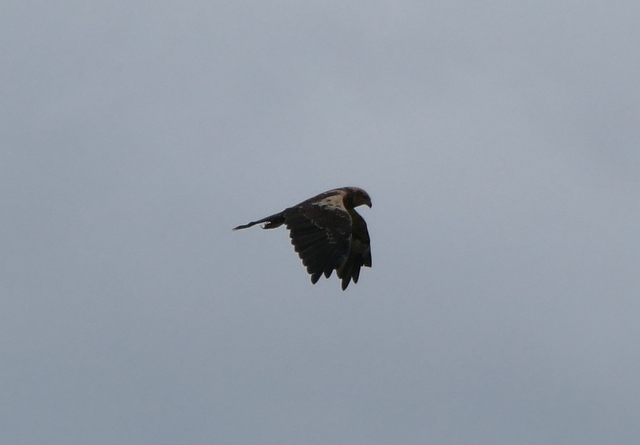 Marsh Harrier – circling over Pat’s Pool
Marsh Harrier – circling over Pat’s Pool
One of the reason the birds are jumpy at the moment is the regular appearance of birds of prey overhead, looking to cash in on the presence of so much potential prey. A female Marsh Harrier circled over, scattering all the ducks and waders, including a couple Common Snipe which had obviously been in hiding in the vegetation around the margin of the Simmond’s. At that point, the flock of Dunlin and Little Stint went back to Pat’s Pool. A short while later, everything scattered from there and we turned to see a Sparrowhawk with something in its talons. The Sparrowhawk landed on the bank and started to pluck its unfortunate victim, looking round nervously. We got a fantastic view of it in the scope as it sat and fed.
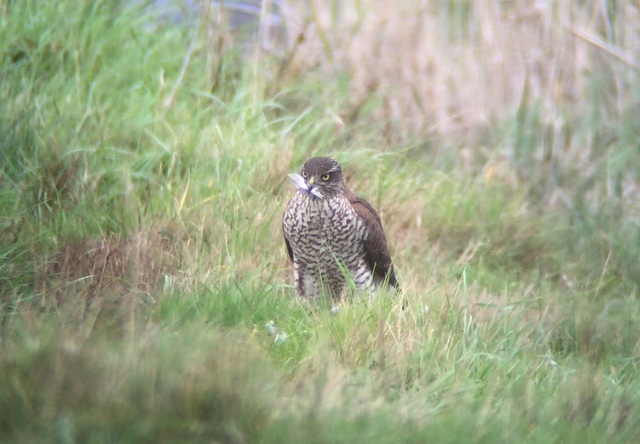 Sparrowhawk – plucking its unfortunate prey on the bank
Sparrowhawk – plucking its unfortunate prey on the bank
We had enjoyed a great morning in the hides but the impact of all the disturbance, warden and raptors, had served to clear out a lot of the birds we had been enjoying. We decided to head round to the beach. On the walk back to the car along the boardwalk, a small bird appeared on the fence along the edge of the reeds. It was a Whinchat, an autumn migrant stopping off on its way south, and we watched it dropping down into the grass and back up to a prominent viewpoint, working its way along the fenceline. While we were watching it, we could hear the distinctive calls of Bearded Tits ‘pinging’ from the reeds, but they weren’t prepared to show themselves in the cool and breezy conditions.
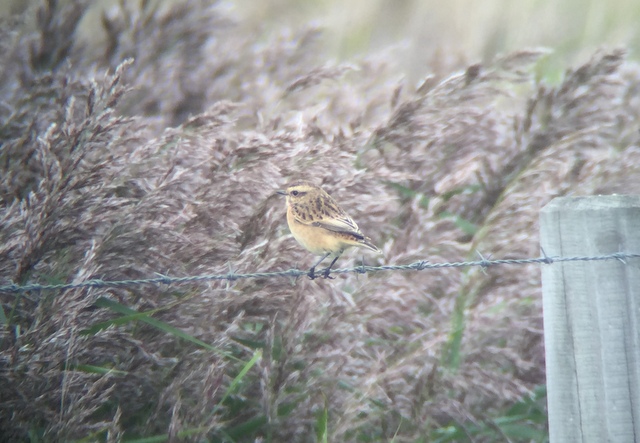 Whinchat – on the fence by the boardwalk
Whinchat – on the fence by the boardwalk
We parked round at the beach car park and walked east along the shingle. A couple of Gannets soared gracefully past, a white adult with neat black wing tips and a darker immature bird. There were also still a couple of Sandwich Terns feeding offshore, plunging down into the waves just off the beach.
There wasn’t much on North Scrape today, probably not a surprise given all the disturbance this morning. Further east we picked up our first Curlew of the day on the brackish pools. Arnold’s Marsh was also a little quiet. The highlight was our only Avocet of the day – most of the birds which were around the reserve over the summer appear to have departed (from the scrapes we can see, at least!). Two graceful Pintail were feeding quietly at the back. Lots of Meadow Pipits were zooming round. A Little Egret fed quietly in the pools the other side of the East Bank, flashing its bright yellow feet.
 Little Egret – feeding on one of the brackish pools
Little Egret – feeding on one of the brackish pools
After such a productive morning, we had worked up an appetite by now so we drove back round to the visitor centre for lunch. We even managed to sit outside! In the afternoon, we drove west along the coast to Stiffkey Fen. The trees along the path were laden with berries – blackberries and lots of haws. A couple of Migrant Hawkers buzzed about our heads. A Speckled Wood basked out of the wind.
 Speckled Wood – basking in a moment of sunshine this afternoon
Speckled Wood – basking in a moment of sunshine this afternoon
The Fen itself has far too much water on it at the moment, so that there was almost nothing left of the islands in view. The big flock of noisy Greylag Geese dominated what was left, with a few Lapwing, Black-tailed Godwit and Ruff clustered in amongst them on the small area of remaining dry land. There were a few ducks, particularly Wigeon again and a few more Pintail. Unfortunately, there was no sign of any Spoonbills her today. We decided to walk round and check out the mud in the harbour.
As we walked along the seawall, a piping call alerted us to a Kingfisher. It shot over the bank from the direction of the Fen and low across the channel beyond, flashing electric blue on the back before dropping down into one of the channels out on the saltmarsh.
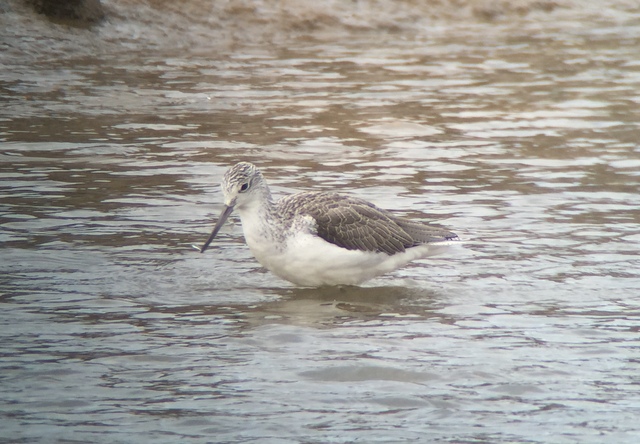 Greenshank – feeding in the saltwater channel at low tide
Greenshank – feeding in the saltwater channel at low tide
A couple of Greenshank were feeding in the saltwater channel, very elegant birds with pale heads and light grey backs. There were more waders on the mud alongside, mostly darker grey Redshanks but in with them a Grey Plover. A second Grey Plover flew in, this one sporting the remnants of its summer black belly, and the two began calling mournfully. With several Curlews calling too, it was a real soundtrack to the saltmarsh in winter!
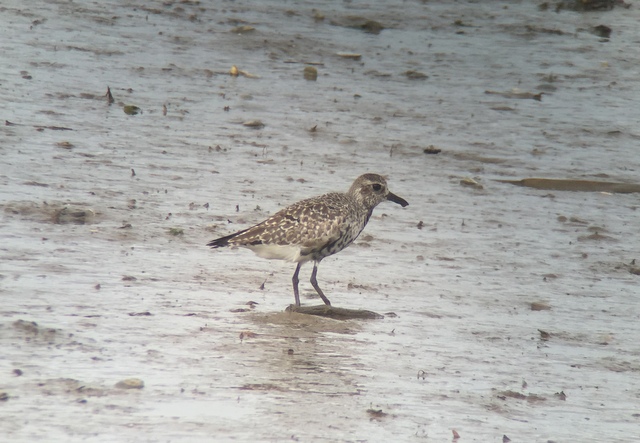 Grey Plover – moulting rapidly out of summer plumage
Grey Plover – moulting rapidly out of summer plumage
Out in the harbour there were lots of gulls gathered on the mud and large numbers of Oystercatcher. With them, we picked up two distant Bar-tailed Godwits. Further over, towards Blakeney Point, we could see as many as 19 Little Egrets gathered in the deepest remaining water, feeding. Numbers of Brent Geese are growing steadily now, as the birds return from Russia for the winter, and we could see several small groups out on the mud.
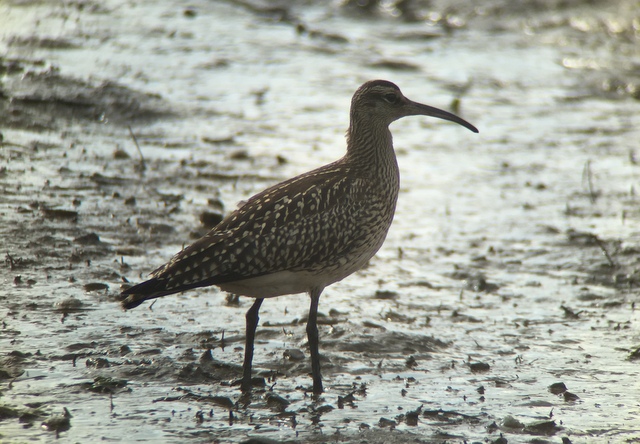 Whimbrel – a very obliging bird feeding by the seawall
Whimbrel – a very obliging bird feeding by the seawall
As we turned to head back, a Whimbrel flew past and appeared to drop down out of view on the saltmarsh. Back at the seawall, we discovered it had landed on the edge of the channel. We stood and watched it for a while and it worked its way right towards us, picking regularly at the stones as it clearly found plenty of food. We got stunning views of it, smaller and shorter-billed than the Curlew with a distinctive head pattern which it flashed at us as it bent down to pick up morsels from the mud. While we were standing there a young Brown Hare (a Leveret) came running along the path in front of us. It only seemed to notice us at the last minute, turning sharply and racing off back whence it came.
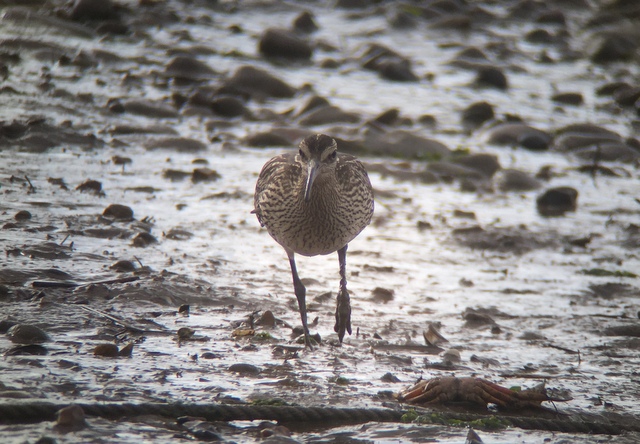 Whimbrel – close up, great views of the distinctive head pattern
Whimbrel – close up, great views of the distinctive head pattern
We still had a little time left, so it seemed like a good idea to have a look at the saltmarshes a little further west. We drove into Stiffkey and down to the coast. On our way, we could see dark grey clouds gathering in front of us. From the car park, we could see some large white shapes on the saltmarsh but we could also see the rain approaching. We decided to sit it out and a good thing too as a heavy squall passed over. Flocks of Golden Plover flew up from the saltmarsh and headed inland overhead as it came in. Finally, the sky started to brighten again beyond and we walked out through the last drops of rain into the sunshine, with a beautiful rainbow in the sky behind us.
 Stiffkey – the rainbow behind us after the rain passed over
Stiffkey – the rainbow behind us after the rain passed over
We were glad we did so. Not only was it a great view, but we could see the Spoonbills fly round as the sun came out. Thankfully they dropped back down to the saltmarsh ahead of us. When the path came out into the open where we could see them, we discovered they were now quite close by, five Spoonbills. We got great views of them feeding in the saltmarsh pools, sweeping their spoon-shaped bills from side to side, yellow-tipped in the adult and dark in the four juveniles. One of the young birds started begging from the adult, chasing it round endlessly, calling and bouncing its head up and down. We have seen the young Spoonbills doing this since the summer, but even now they are not giving their parents any peace!
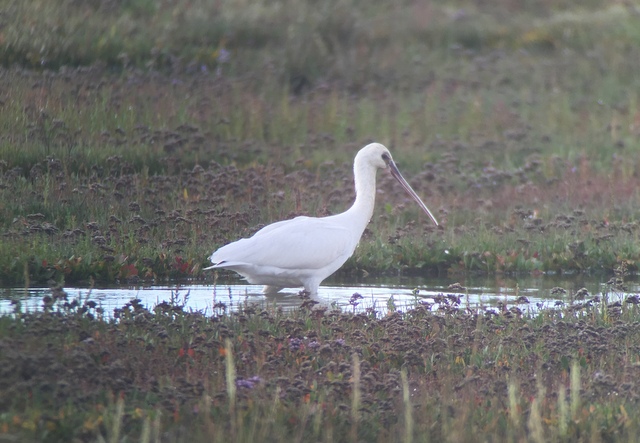 Spoonbill – one of five feeding on the saltmarsh
Spoonbill – one of five feeding on the saltmarsh
There were several Marsh Harriers out quartering the saltmarsh and just before we turned to head back, a quick scan revealed another large bird further out. Its distinctive rowing wing action immediately gave its identity away, a Short-eared Owl. It circled up high into the sky – a real bonus.
We thought that would be a good way to end and, with more grey clouds gathering, we started to walk back. However, the day had not finished yet. A short way down the path, a Barn Owl appeared hunting over the field just inland. We only got a quick glimpse of it, but as we came out of the bushes into a more open area we stopped to scan the field and a Whinchat appeared on the top of some dead umbellifers along the margin. Then a second Whinchat popped up nearby. Several Brown Hares were also in with them. Further up the field, another bird perched up on the tall stubble – a Wheatear sunning itself. It looked stunning in the afternoon sun with the dark grey clouds gathering beyond.
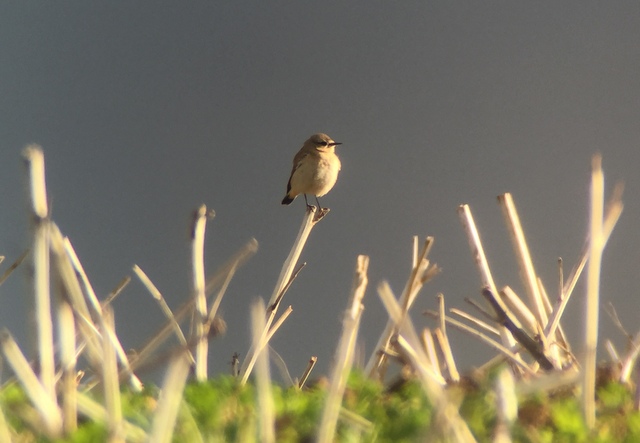 Wheatear – perched up in the sunshine between the rain
Wheatear – perched up in the sunshine between the rain
A Sparrowhawk shot through low across the field, scattering the little group of birds we had been watching, as we packed up and continued on our way back. But just round the corner, we spotted the Barn Owl again, hunting along the grass on the edge of the saltmarsh. We watched it working its way away from us, before it dropped down into the Suaeda where we could just see it perched through the scope, before it continued up into the campsite wood beyond. What a great way to finish the afternoon, but it was now time for us to call it a day and head home.
















